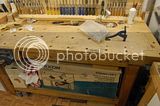Will_Price
Member
Hello Everyone!
I need some advice on a project im taking on. Im copying a design for a new work bench from a really good book from the states, the design is 19th century french and requires quite alot of timber to build.
In the book the authour uses southern yellow pine which is apparantly one of the most common structural timbers in USA. In the book he advises buying 2" X 12" and ripping down the make a laminate block worktop and the same process for the legs. I need to find a timber AS CHEAP AS POSSIBLE. I would buy our structural timber common here but my boss seems to think it wont plane up nicely enough?...
Any advice?
I need some advice on a project im taking on. Im copying a design for a new work bench from a really good book from the states, the design is 19th century french and requires quite alot of timber to build.
In the book the authour uses southern yellow pine which is apparantly one of the most common structural timbers in USA. In the book he advises buying 2" X 12" and ripping down the make a laminate block worktop and the same process for the legs. I need to find a timber AS CHEAP AS POSSIBLE. I would buy our structural timber common here but my boss seems to think it wont plane up nicely enough?...
Any advice?







